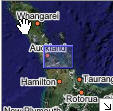Augmented Technology....research in this area of technology has been around for awhile. You have seen it on TV or in the movies....Tom Cruise standing in front of a glass grid of a map - from a projector that is fitted into a glove he is wearing comes a virtual elevation of the terrain that he can interact with. Fiction? Not really...............
Augmented Technology is an area of computer research which deals with the combination of real world and computer generated data. Some examples of this are used in/with:
- GPS devices
- Virtual Reality (VR) projects (ie: airplane simulation training for pilots)
 LifeClipper
LifeClipper combines GPS, VR and Real Life. The participant puts on the gear - a portable computer (pictured to the right) and then walks around a designated route. The experience is as if they are in a movie, it combines what they see around them during the walk along with photo, video and sound that is seen through the goggles at predetermined points captured by GPS.
This takes the meaning of a
virtual class field trip to a whole new dimension. Imagine visiting the site where The Treaty of Waitangi was signed and with the help of this technology students could feel like they were actually witnesses this time in history occurring.
 HUD (Heads up Display) HUD is a display on the screen that doesn't block the user's view. This is already being used in many domestic cars where the speedometer and other stats are projected up onto the windshield for the driver to view (BMW, Nissan, Lexus, Citroen, and GM all offer HUD.)
HUD (Heads up Display) HUD is a display on the screen that doesn't block the user's view. This is already being used in many domestic cars where the speedometer and other stats are projected up onto the windshield for the driver to view (BMW, Nissan, Lexus, Citroen, and GM all offer HUD.)
There are now prototypes to project a GPS street system onto your screen rather than having to purchase a separate unit for your vehicle.
How man students have complained that they can't read the
projector screen because it is too small?

The new projectors being developed and tested in the Faculty of Architecture at the
Bauhaus-University Weimar are short of amazing. Not only do the dual projectors take a corner of a wall to make one large smooth image it can use augmented technology to give a projection depth....a 3D feel.
Explore the projects photo gallery.
Further links:
How Stuff Works - Auglmented Technology
 Dance is a freeware application (free to try - register to keep) that helps a dancer learn dance patterns. Over 200 patterns available and the ability to create your own dance patterns as well. The ability to animate, print and export patterns. Many patterns now also have a support video/picture sequence of actual dancers.
Dance is a freeware application (free to try - register to keep) that helps a dancer learn dance patterns. Over 200 patterns available and the ability to create your own dance patterns as well. The ability to animate, print and export patterns. Many patterns now also have a support video/picture sequence of actual dancers. SimpleDance is based on the Dance software above. (although SimpleDance is free, it doesn't seem to have had any further development into it for a couple of years).
SimpleDance is based on the Dance software above. (although SimpleDance is free, it doesn't seem to have had any further development into it for a couple of years). Credo Interactive specializes in 3D character animation software.
Credo Interactive specializes in 3D character animation software. 









































